Six: The Musical: The Little Musical That Could, Did, and Does
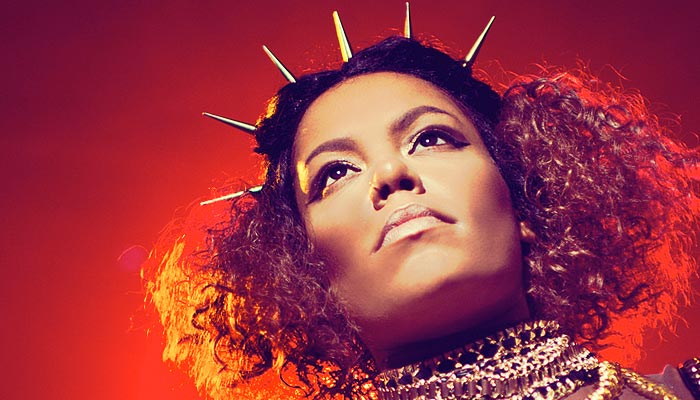
Six: The Musical. often rendered as SIX: The Musical, is one of the newest musicals on Broadway. A British pop musical written by Toby Marlow and Lucy Moss, it started out as a student project, conceived while the writers were studying for finals at Cambridge University. Possibly composed as a stress-reliever, with a tiny cast of six and a slightly bigger number of songs (only eight), this musical should’ve arguably never reached the heights it has.
Six encountered more problems when the COVID-19 pandemic delayed its American Broadway premiere in spring 2020. The production was at first postponed, but as American federal and state governments moved the goalposts for returning to normal, it seemed Six would never see the spotlight it needed to become as big as other recent hits like Dear Evan Hansen or Hamilton. In fact, some critics disdained, and continue to belittle, Six because it’s smaller and formatted differently than most musicals. Particularly when compared to the 2015 epic Hamilton, Six could be called silly. After all, what is a few pop numbers sung by modernized historical women, when compared to a traditional two-act production about a Founding Father?
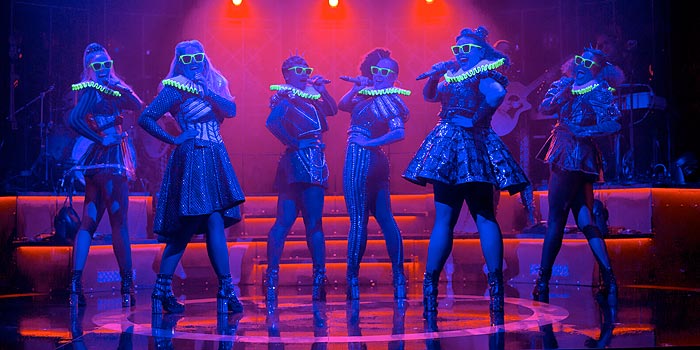
This musical hasn’t given up, though. Thanks to virtual performances and intense social media support, Six maintains its place in the spotlight while awaiting a traditional American debut. This writer is herself a big fan and would love playing one of the queens if the opportunity ever arose. But not every writer or critic has to be a fan, a theater aficionado, or even familiar with the Tudor period, to appreciate the many lovely facets of Six. This production is a musical simultaneously for and ahead of its time, combining history with modernity and femininity with power and diverse personalities. It’s a musical that sticks in your head even if due to ticket costs or COVID-19 restrictions, you haven’t seen the show. It is, more than anything, a musical that deserves full analysis and appreciation for what it has done and continues to do–things that musicals of the past and present haven’t dared to do yet.
A Celebration of History
We’ll begin our discussion with Six’s backdrop, the lives of six Tudor queens. The Tudor dynasty itself was short-lived, with Henry VII’s son Henry VIII taking the English throne in 1509 after the death of older brother Arthur. Henry had one surviving son, Edward, who ruled mainly as a boy king and died only a few years into his reign. Since Henry’s last surviving heir, Elizabeth I, never married, the Tudor line died with her. Within the line however, are Henry’s famous six wives, each married to him for tumultuous periods in hopes of providing the male heirs and long-lasting legacy he craved. Six invites the queens to tell their individual stories on their own terms, rather than as part of “his-story” wherein, without a link to Henry, they “disappear.”
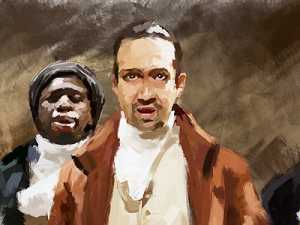
However, Six is not a straight historical musical like Hamilton or some predecessors such as 1776. The queens’ life stories are not told as such. Instead, the queens are resurrected as female pop singers looking to form a group. In each show, they perform the same concert for the audience as a contest. Whoever the queens determine had the hardest life with Henry will get to be the group’s lead singer. Thus, each queen tells her story in song, using preferred genres and modern arrangements and inspirations. Katherine of Aragon gets a Beyonce-style song with Latin flavors. Anne Boleyn is compared to Avril Lavigne, because of how “complicated” her queenship was, according to the writers. Katherine Howard, the youngest queen, has a song that’s been called “bubblegum,” despite its serious themes of exploitation and sexual abuse. And so goes the rest of the show, with each queen using catchy lyrics, unforgettable beats, and clever wordplay to explain how it felt for her to be the head that [wore] the crown.
Because of, and not in spite of its pop feel, Six also makes history fascinating. In the British and American incarnations of the show, the queens poke fun at stuffier ways of retelling their stories. They quip that audiences might remember them from BBC or PBS, but that’s not the kind of story they’re here to tell. They make fun of the mnemonic trick, “Divorced, beheaded, died, divorced, beheaded, survived,” that students often use to remember their “names and fates and faces,” excoriating it. “I’m done, ’cause all this time/I’ve been just one word in a stupid rhyme,” Katherine Howard sings. Indeed, the queens go far beyond the “stupid rhyme.” “What about the glories and the disgraces,” Anne of Cleves points out in the opening number “Ex-Wives.” The queens sing joyfully of their intent to “overthrow” history by “taking back the microphone,” and they do so in ways audiences won’t forget.
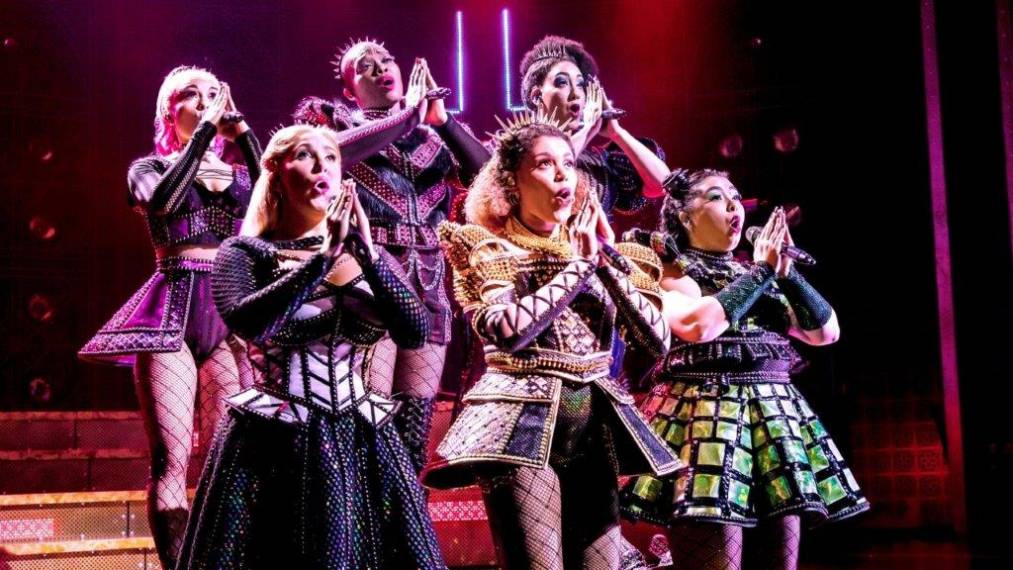
Each queen’s featured song pulls back the curtain on her point of view on life with Henry VIII. Not every historical detail is entirely correct or accepted as canon; for instance, the show takes the stance that Anne Boleyn was a ditzy homewrecker, while historians like Tracy Borman credit her as an extremely intelligent calculating woman with an interest in her kingdom (whereas the show’s Anne sings, “Politics? Not my thing”). Such liberties, however, are not meant as malicious toward real history or character smears on the queens. They are instead meant to show the queens as real women with an over-arching real problem–marriage, often forced, to a man obsessed, arguably unstable, often abusive, and power-hungry.
Our protagonists explore the parts of history that don’t get a lot of attention because they aren’t deemed serious or scholarly. For instance, Jane Seymour gets credit–and backlash–for being “the only one [Henry] truly loved.” Historians agree Henry called her “my first true wife.” But Jane also lets us know that role came with a lot of pressure, perhaps more than that of the previous two queens. “I know without my son your love could disappear,” she sings in her ballad “Heart of Stone.” Later on, Anne of Cleves explores what it might’ve felt like to be the almost immediately divorced fourth wife. History agrees that Henry came to look on her as a favored, even beloved, sister–but Anne was still left to herself after being set aside. She explores the positives and negatives of her position in “Get Down,” noting that she loves the single life, but remains hurt because of Henry’s treatment. When Anne calls Henry a “dirty rascal,” she means it in more ways than one, and holds him accountable in ways the other wives didn’t and probably couldn’t.
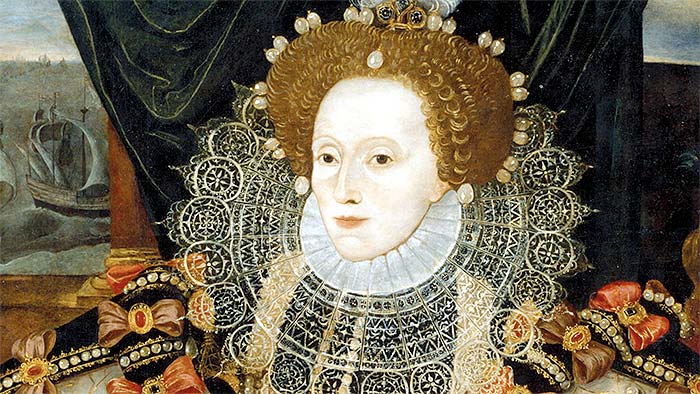
In addition to exploring lesser-known history, Six: The Musical speaks to the realities of the Tudor period and subtly compares them to modern attitudes. Again, this can be found throughout all eight songs. Katherine of Aragon corrects Henry’s claim that their marriage was incestuous and that “I’ll end up kiddie-less all my life,” pointing to the birth of Mary and saying, “Daughters are so easy to forget.” Indeed, as we’ll see in the next section, daughters, wives, and women still struggle against direct male oppression or covert superiority from men. Anne Boleyn points out the double standard that Henry can “go mental” when he finds out about her “[flirting] with a guy or three”–while he sleeps around constantly. Again, the double standard still exists. Katherine Parr spends her song speaking of her achievements in female education and the arts, reminding theater-goers or soundtrack listeners that women have come a long way but still have plenty of ground to conquer.
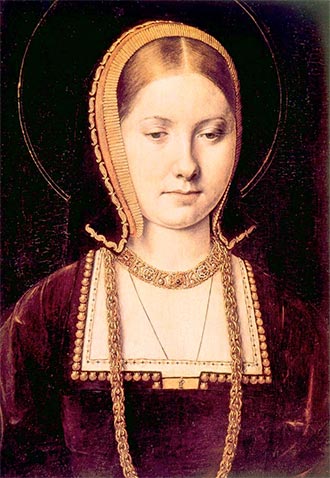
The modern connections aren’t just about feminism, either. For example, Katherine of Aragon references her Catholic faith both in her lyrics and in parts of her song’s arrangement (one section sounds much like a women’s choir). Again, this is a spotlight on early Tudor life, during which England was still a Catholic country, and during which Henry VIII claimed devout Catholicism. Yet it’s also a subtle nod to how Katherine, and modern people, used or use faith to cope or strengthen themselves in tough situations. Jane Seymour’s ballad “Heart of Stone” contains the line, “Soon I’ll have to go/I’ll never see him grow.” On the surface, this is acknowledgement that many women of her time died in childbirth. But Jane goes on to explain that she’ll always be by Edward’s side because her “love is set in stone,” paying tribute to the difficulty, yet eternal rewards, of motherhood. Katherine Parr begins her story with a regretful “breakup song” to a love she had to leave behind for Henry, presumably Thomas Seymour, whom she married after the king’s death. Women and men have pointed out how universal Katherine’s emotions are, and favorably compared “I Don’t Need Your Love” to other modern breakup songs inside and outside musical theater. All these and other examples throughout the show are reminders that history, conventions, and traditions change, but experiences, emotions, and choices are universal. Therefore, they remain relatable in all kinds of contexts.
A Celebration of Women
Not everyone takes Six: The Musical seriously, especially when its modern pop feel and historical license is coupled with an all-female cast. However, the naysayers would do well to note Six is one of the only 21st-century musicals with an all-female cast. That cast, the women behind the characters, and a female head writer, have made men and women take to social media in support. Comments range from, “[This musical] has SIX. FEMALE. LEADS. Do you know how rare that is?” to headcanons, fanart, and creative dialogues in support of the queens and their stories. The feminist aspect is almost a foregone conclusion, but Six is far more than the “rah-rah feminism,” “bubblegum” production some people might stereotype it as.
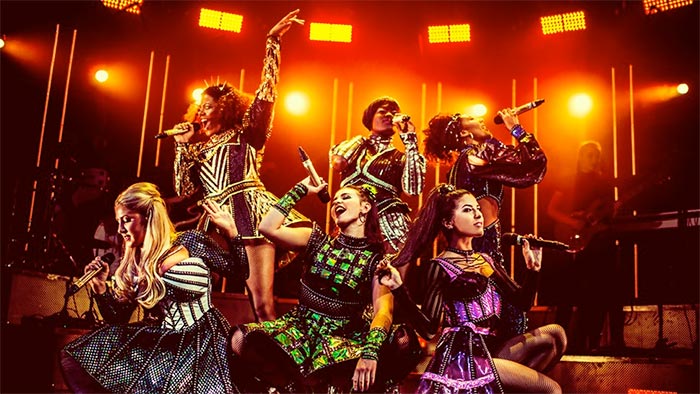
The biggest part of feminist celebration in Six is how each queen is given a distinct personality. Some personality traits come through in the queens’ songs or lines, while others are more subtle and give them more depth. A great example is how each queen gets her own color and costume design, and how the colors are used to symbolize each one’s journey, life with Henry, and self. Writers Moss and Marlow have discussed this at length on the musical’s website and social media. The queens are “coded” and designed thus:
Katherine of Aragon
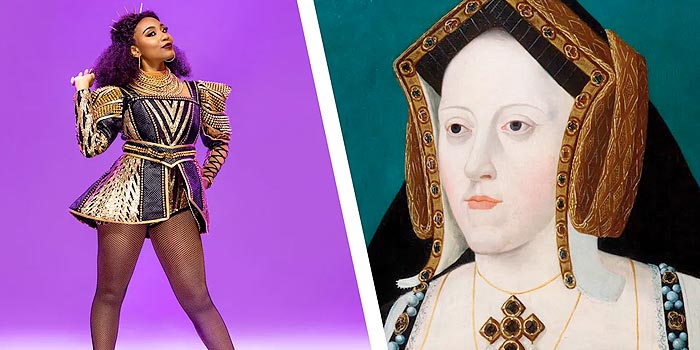
Henry VIII’s first wife, she was married to him for 24 years, longest of any Tudor queen. She calls herself “a paragon of royalty,” and dresses in gold, which is associated with royal or superior status. Gold could also be read as a nod to Katherine’s devout Catholic faith, either the elaborate iconography and rich history of the Church, or Katherine’s “gold” status as the true wife in the eyes of the Pope and arguably God. Although Katherine wears a pop costume like the other queens, Tudor sleeves and higher necklines were used as cues to her faith and modesty. Katherine is also the only queen whose headpiece resembles a tiara. Again, this is a nod to her status as Henry’s only “true” wife. The historical Katherine maintained her position from divorce to death, refusing to acknowledge herself as illegitimate or Mary as a bastard. “You made me a wife/So I’ll be Queen to the end of my life,” Katherine sings in the show. There’s “No Way” she’s giving up her crown.
When designing Katherine of Aragon’s costume, the musical’s writers and designers both noted yellow is the Spanish color of mourning. On the surface then, Aragon’s gold/yellow costume is a nod to the real Aragon’s Spanish heritage, of which she was intensely proud and with which she raised daughter Mary. Below the surface though, the yellow tones along with the gold point to the saddest parts of Katherine of Aragon’s story. She is not the only divorced Tudor queen, but she lost a 24-year marriage. She also had to contend with pressure to proclaim said marriage incestuous, and herself and her child illegitimate. For a devout queen like Katherine, who raised her daughter to be the same, such confessions would be spirit-crushing in the extreme.
On top of this, history tells us Katherine spent years, including her last ones, forcibly separated from her only living child. Yes, she is determined not to give up, but under that determination is plenty of mourning, anger, and regret.
Anne Boleyn
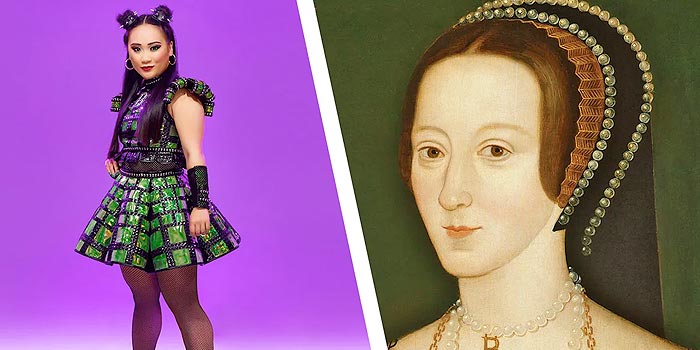
As noted, the show’s Anne is compared to Avril Lavigne because of her “complicated” queenship. Beginning as a lady-in-waiting to Katherine of Aragon, she caught Henry’s eye around 1526. Historians and “pop historians” such as fiction writer Alison Weir are divided on whether Anne set out to wreck Henry’s marriage or if she was innocent and only insisted on being Queen because of deep Protestant faith and a desire not to be a mistress.
The show splits the difference. Anne acts and sings like a flirtatious homewrecker, and her dominant color is green. Green is often read as the color of money, ambition, or greed, and Six does present Anne as a social climber. But green can also symbolize health, good luck, and resurrection. Anne’s constant refrains of “I didn’t mean to hurt anyone,” “I’m just trying to have some fun,” and “What was I meant to do” point to her as at least partially innocent, with few choices once Henry decided he wanted her. Her green sleeves are played up, partly because of the legend that “Greensleeves” was about her. The sleeves can also be read as a symbol for the ardent, heavily romantic love Anne and Henry enjoyed in the beginning of their relationship. When we consider the black highlights of Anne’s costume, the tragedy of her beheading hits home hard. In fact, hearing Anne sing so glibly about getting executed can be downright disturbing when we recall it actually happened to a real woman.
Anne also wears a choker to signify her “beheaded” status. She wears hoop earrings instead of a crown, symbolizing that while Henry loved her for a time, her queenly status was cut short and later unacknowledged. Yet, Anne Boleyn remains perhaps the best-remembered and oft-studied of Henry’s six queens, to the point that countless books and documentaries have been dedicated only to her. Her song “Don’t Lose Your Head” could be read as her way of resurrecting her legacy and insisting on life and vitality in history.
Jane Seymour
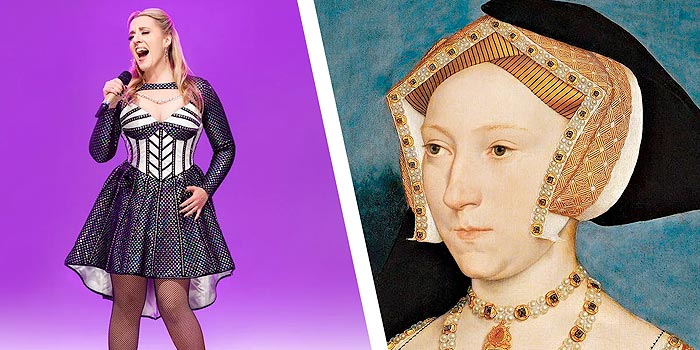
Henry VIII’s third wife, Jane Seymour was lady-in-waiting to both Katherine and Anne. Near the end of Anne Boleyn’s reign, she was the king’s next mistress. Jane was called Henry’s “first true wife,” according to Tudor historians like Lucy Worsley. In the show, Jane is “the only one he truly loved.” Her dominant colors are white and black, and are often rendered as white and silver-black. White represents purity and modesty. Historically, Jane is painted as the meekest wife, to the point of stereotype. In her costume, the mixture of white and black represent designs of Tudor houses, which might point to Jane as the queen who persuaded Henry to treat her, and his children, as members of a complete family. In “Heart of Stone,” she sings, “You say we’re…a perfect family/you hold us close for the world to see.”
In addition, the white and black of Jane’s costume symbolize the tragedy of her too-early death, her purity in death, and the fact that she was the only Tudor queen to receive a queen’s funeral. The Fandom Wiki of “Costume Meanings” also notes Jane’s costume is the least revealing of any cast member’s, with a higher neckline even than Aragon’s, longer sleeves, and a skirt at least to knee length. The silver detailing on Jane’s costume underlines her kind, gentle personality.
According to some sources, silver is used as a “mirror to the soul.” Considering Jane’s status as Henry’s “true love” and one of only two queens who didn’t incite his abuse, this could be read as Jane being Henry’s “mirror.” She sees who he is and who she is with him, and seeks to improve the situation by being modest and gentle rather than trying to compete with Henry in intelligence or other acumen. Perhaps most importantly, silver symbolizes Jane’s queenly status. She is not the true, gold queen Katherine of Aragon was, but she is the only other wife treated fully as a queen. Thus, she wears silver as a secondary, more understated royal color.
Anne of Cleves
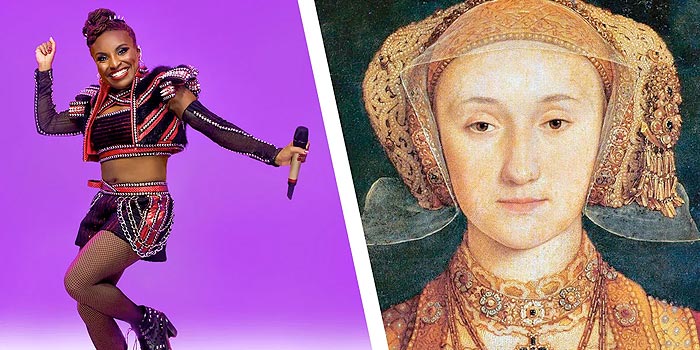
Also known as Anna of Cleves, Anne married Henry as part of a strategic alliance with Germany. Henry infamously divorced her after six months because, as the show’s Cleves puts it, “I didn’t look as good as I did in my pic.” Historically, Henry is said to have proclaimed Anne was a “horse” or “the Flanders mare.” Yet Cleves did live her divorced life as a single woman and Henry’s “sister,” in palaces he gifted her and with free access to court. Marlow, Moss, and fans note Anne won Six‘s competition if we go by the fact she never endured abuse or exploitation, or other marriages.
The show’s Anne of Cleves is color-coded red, widely known as the color of fire and passion. Anne’s song “Get Down” is full of passion, as she glories in her ability to make a splash at court and do whatever she wants in her own home. “Spill [mead] on my dress with the gold lace trim/not very prim and proper/can’t make me stop,” she sings. She later sings about her “jam” coming on the lute and looking “more rad than Lutheranism.” According to Moss and Marlow, her song is “a celebration, the most dance-heavy.” It’s arguably the most feminist, encouraging listeners to “get down.” Her red and black costume underscore the earthiness of the lyrics, as she sings about being brought pheasant kept on the bone, going hunting, and “having a little flirt with the footman” because “[I] don’t got no marriage.”
Instead of a skirt, Anne also wears shorts, symbolizing her freedom. In the original costume design, chains “drip down” the shorts, further symbolizing the chains she escaped. Like Katherine of Aragon, the other divorced queen, Anne of Cleves wears spikes on her headpiece, representing wealth and the “spiky,” painful nature of divorce.
Katherine Howard

Henry VIII’s youngest queen, Katherine Howard was only 19 when she died. Like Boleyn, she began as a lady-in-waiting and was executed on suspicions of adultery. History records her as promiscuous, yet innocent and exploited. One alleged affair with courtier Thomas Culepper still incites debate over whether the sex was consensual.
According to Six, Katherine did not consent and was a plaything to the men in her life. Like Anne Boleyn, her song has refrains that testify to this, notably, “I thought this time was different,” “We have a connection,” and “Playtime’s over.” In addition, her song never explicitly mentions sex. Instead, Katherine uses phrases that, while innuendos, could be read as childish. “All you wanna do is…touch me, please me, birds and the bees me,” her chorus tells us. If the singer were anyone but a Tudor queen in a promiscuous court, we might think Katherine Howard was singing about being cuddled, caressed, and doted on in a totally platonic manner.
Katherine’s costume also reflects the promiscuity, yet tragic elements, of her story. It is the most revealing of the cast. As the costume shows off Katherine’s body, viewers are meant to reflect on how she was treated as a plaything and might see herself that way despite disliking the characterization (“Playtime’s over”). In addition, her costume is predominantly bright pink. Pink is associated with young, immature girls, as well as vitality and a level of innocence Anne Boleyn didn’t have. (Remember, green can be read as calculating, which Anne might have been because she was older and more experienced). The original design makes use of black, perhaps pointing to how Katherine lost her innocence and life. Like Anne Boleyn, Katherine wears a choker as a symbol of beheading.
Some parts of Katherine’s costume testify to her attempt to rise above exploitation and the unfair expectations placed on her sex. Her sleeves are long, which at first seems incongruous. However, according to the Fanon Wiki and musical writers, the long sleeves symbolize Katherine’s desire to be mature. Fans speculate the sleeves are a last attempt to protect what modesty she still has. They are a sort of armor, as Katherine tries to hide vulnerability.
We hear this in her song too, as she tries to act casual about her encounters with men, using phrases like, “Yeah, that didn’t work out. So I decided I needed a break from boys.” In addition, like Anne Boleyn, Katherine wears hoop earrings instead of a crown. This points to the fact that she was loved for a time, “played with,” maybe even given royal jewelry, but never elevated to true queenly status in Henry’s mind.
Katherine Parr
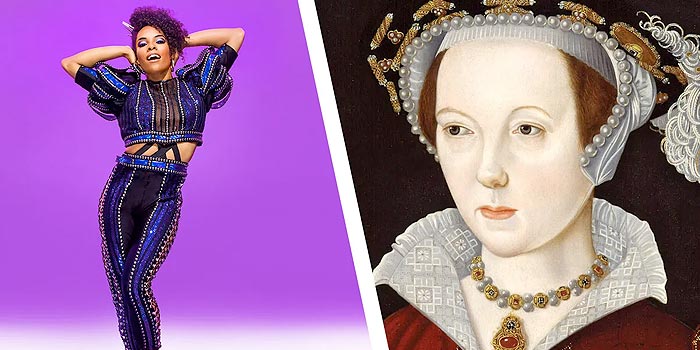
“I’m the survivor, Katherine Parr/I bet you wanna know how I got this far,” Katherine boasts in her “Ex-Wives” intro. Indeed, she got the farthest of any wife where marriage was concerned, outliving Henry by one year and surviving marriage without the threat of divorce. (She was nearly arrested for heresy, but talked Henry out of it). Katherine gets far in the show, letting the other queens know the competition is stupid because they all had a horrible time with Henry. The point, she says, is that they’re all onstage now, telling their stories on their terms. They don’t need Henry’s love to be significant or claim places in history. It’s not just “his-story,” it’s theirs.
Katherine Parr’s costume and dress reflects her unique positions as survivor, peacemaker, and bold queen. She wears trousers or a jumpsuit instead of a skirt. As with Anne of Cleves, this symbolizes freedom and flexibility. It points to how flexible, and clever, Katherine Parr had to be to keep her position and head.
As for clever, her costume is predominantly royal blue. Blue is associated with wisdom, intelligence, and calm. Katherine’s level head and a personality quieter than other queens’, when balanced with smarts, probably kept her alive. Additionally, royal blue is a great conduit for Katherine’s song lyrics, as she talks about fighting for female education, writing “books and songs and meditations,” and in general, making women more visible during her era. “I even got a woman to paint my picture,” she sings, adding, “Why can’t I tell that story?”
Like Katherine Howard, Anne Boleyn, and Anne of Cleves, Katherine Parr doesn’t wear a crown or tiara. Instead, she wears hoop earrings like Boleyn and Howard. But instead of symbolizing beheading or tragedy, with Parr, the earrings symbolize her survivor status. Like the other queens, Parr is a part of the “circle of life” of Henry’s reign. Like the others, she received jewelry and gifts. But in specifically outliving Henry, rather than surviving because of a divorce like Cleves, Parr is the only wife to complete the circle. She triumphed in her relationship with Henry and arguably “wore the pants” as much as a woman of her era could (hence her trousers in the show). The show’s version of Katherine also makes clear she chose to live her life without Henry’s control as much as possible, even though unlike Anne of Cleves, her marriage was intact.
A Celebration of Individuality
As clear as the musical’s feminist subtext is, there’s a far larger subtext at work, too. Six is not only a celebration of women, but a celebration of people and how they can become who they were meant–according to some, created–to be. Every casting call makes clear all women are welcome to audition, no matter their body type, race, orientation, or voice type. The way the roles are written reflect this commitment; no queen is specifically written as a certain type of person.

Nor are auditioning women expected to play only roles that “fit.” For example, in the original production, Katherine of Aragon is played by a Black American woman, not a Latina as one might expect for the role of a Spanish queen. Anne of Cleves, historically German, is also essayed by a Black woman, and Katherine Parr is a Latina.
In addition, women as old as 35 are encouraged to audition, while in traditional theater, lead female roles usually go to women of ingenue age only. And while “a great pop voice” is a must, no roles are specified as soprano, mezzo, or alto only. Women of all body types are encouraged.
As a disabled woman who was often shut out of theater or only allowed to participate a little bit, has been everything from skinny to zaftig, and is a mezzo, this writer draws hope from that call. She hopes other musicals and plays will follow its lead, as they have not in the past. Yet even if the casting calls weren’t blatantly inclusive, Six would still be an inclusive musical that attracts all kinds of actors and viewers. This is mostly due to the different ways the queens approach their relationships with Henry, and how they eventually support each other.
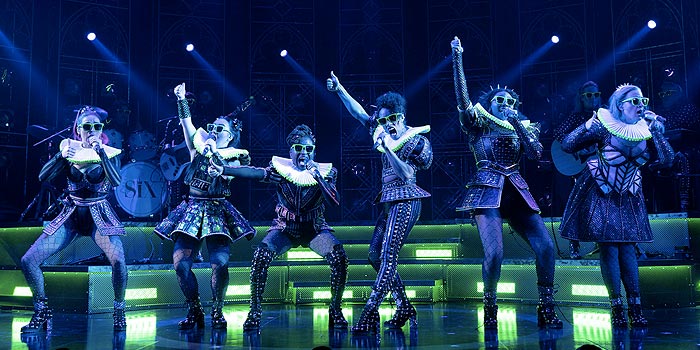
Each queen communicates her relationship with Henry VIII was individual and integral to identity, without defining herself by it. As with their songs and costumes, the queens’ personalities come through in how they relate to Henry. Katherine of Aragon, a warrior queen but a gentle presence, devout but not demure, calls Henry out on tossing her aside. “If you thought it’d be funny to send me to a nunnery/honey, no way,” she says, adding, “I won’t back down, won’t ‘sh,’ and no, I’ll never leave!”
Anne of Boleyn admits Henry was fun and romantic at first, but then gives vent to her frustrations with his unfaithfulness and fear of how he will retaliate against her alleged cheating. As for Jane Seymour, she commits to love Henry no matter what, to be there for his children, and try to change his trajectory for the better. “It isn’t fair, but I don’t care/my love will still be here,” she tells him.
Anne of Cleves, Katherine Howard, and Katherine Parr, the next set of “divorced, beheaded, and survived,” take similar but individualized tacks. Anne of Cleves makes clear her intention to stick around, but unlike Aragon, she won’t wait for Henry to realize the error of his ways. She’s going to live it up right in front of him and rub it in his face. Like Anne Boleyn, Katherine Howard laments her lack of connection with Henry, singing, “Why did I think this time was different?” Her song clearly communicates her longing for real love, no strings, no playing around. The fact that she doesn’t get it–and is murdered–makes her story more of a tear-jerker and anger-inducer than Anne Boleyn’s.
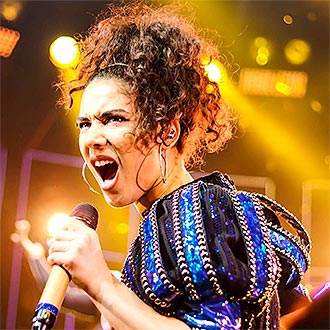
As for Katherine Parr, she takes part of a page from Jane’s book, using kindness and patience to tame Henry’s inner beast. But she also borrows from Aragon and Boleyn, both noted in history for their independent spirits and intellectual prowess. She uses smarts to keep her position, and maintains that she may be queen, but “I’ll never belong to [Henry”]. Parr even dares him to tell her otherwise in private, wishing she could tell him to his face to “get a clue.”
Through these six relationships, we get portraits of what “wife” and “queen” mean to six extremely different women. On one stage, we get a pressed but not crushed warrior, a calculating vixen, an “ideal” wife and mom, a kick-butt, cool “maiden aunt,” a “broken bird” ingenue, and an intrepid survivor who expects to be treated as a partner. Not only are these roles diverse when compared to female ones in traditional theater, they show that each queen had choices and made the ones truest to her. Again, this may not be historically accurate, but it takes what little we know about these women and honors who they might have been and could have become.
Nowhere is this more apparent than near the end of the show. Having watched the other five queens compete and tear into each other, Katherine Parr uses her turn at a solo to remind them of what they have in common. All the queens heard from Henry, “You need my love,” and in one way or another, they were forced to take it, flawed and selfish though it was. When Katherine chooses to tell her own story rather than a story revolving around being wife number six, it spurs the others to “take back the microphone.” Without Henry, they have always disappeared, but no longer. Instead, each queen sings of what she would’ve become, had she been allowed.
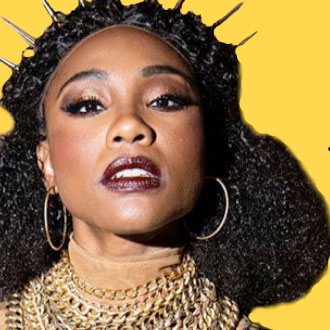
The resulting stories are touching and uplifting. Katherine of Aragon enters the convent by choice and becomes the star of a “top of the charts” gospel choir. Anne Boleyn “[blows] their minds” with her songwriting talent and becomes a lyricist for “Shakesy-P,” while Jane apparently chooses to stay with Henry and his three kids, mother several more children, and start a family band. While “The Royal-ing Stones” take off, Anne of Cleves moves back to her hometown and shows her haughty compatriots “how to party.” Katherine Howard swears off men, learns all she can about singing and music, and launches a solo career. As for Katherine Parr, she tracks down the other five and “[lays] down an album.” “Now all I need is Six,” she sings, indicating the queens have decided to work together and carve out their own stories.
A Celebration of Empowerment
Of course, Six might still offend historical or theatrical purists. Failing that, some in the target audience, mostly young women, might find the underpinnings offensive. This writer herself remembers wondering, does the queens’ empowerment mean 21st-century women are meant to think abuse and exploitation are okay? Her evangelical Christian background also caused her to question or disapprove of some choices, from the two Anne’s perceived casual attitudes toward sex to the way Katherine Howard discusses exploitation as normal, to how much Jane Seymour accepts and loves Henry.
It’s true, most audience members will find themselves identifying with or supporting some queens over others. This writer is much more comfortable with Aragon, Parr, and Seymour, for one. Yet as this writer and others has and will discover, the point of Six is not to say abusive attitudes, sexual exploitation, or other sins are okay if you come through them “empowered.” Nor is the point to slap the face of marriage and motherhood, as some in this writer’s and other tribes might claim. Six isn’t shy about the gritty realities of Tudor history or the modern treatment of women. But when they appear to condone some choices and belittle others, the production does the opposite.
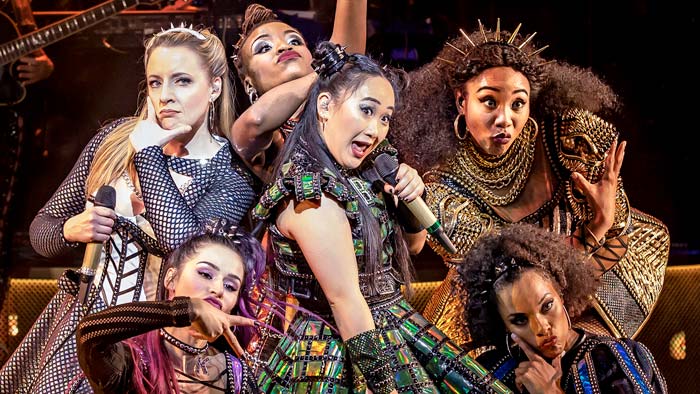
A Six fan with an analytical bent and keen senses will notice the delicate balance the Tudor queens strike between the constraints of their era and the freedoms they would have had if the overall story had been different. To varying degrees, each queen either calls out Henry directly, or communicates how he and his quest for power damaged them. When a modern woman–or man–hears Katherine of Aragon repeatedly say “no way,” they’re meant to hear, “No way should you take abuse from anyone.” When they hear Anne Boleyn and Katherine Howard’s desperation and lamenting, they’re meant to recognize, “Women of both eras got, and still get, trapped. Their bodies may not die, but their spirits will, unless they get legitimate help breaking out.”
Even Jane Seymour, with her “heart of stone,” doesn’t reserve her deepest and most determined love for Henry. Instead, her song quickly switches from addressing Henry to newborn Edward. Jane recognizes she won’t get to raise her son, but leaves a legacy of pure, unconditional love for him. Her underlying message becomes, “Make the right choices for yourself and vulnerable people you love.” And although Jane died of natural causes, she has a deep message for women facing abuse–“Don’t wait until your body or spirit die before getting a stone spine and determining your legacy for yourself.” She declares, “You can build me up, you can tear me down/I’m unbreakable/You’ll find that I’m unshakeable,” and she is arguably the most unshakeable queen. Still, she cautions listeners that “unshakeable” can sometimes lead to unhappy endings, so it shouldn’t be taken as far as Jane took it.
As for Katherine Parr, she’s the survivor in more ways than one. She speaks to and for not only women who have survived domestic abuse, but women who have survived any other circumstance in which they’ve been trapped. She communicates survival is possible, and that one’s story doesn’t have to be tied up in anyone else’s, even if the other person has power, influence, or other advantages.

Katherine Parr is in fact this writer’s favorite, imparting hope to a woman marginalized because of cerebral palsy and Asperger’s, told, “We have the power because our bodies are ‘normal’, we socialize ‘normally,’ and we don’t need modifications to be independent.” Yet because of Katherine Parr, every queen can take on a new mantle as a survivor with a story to tell. More importantly, every modern woman can take that mantle. Whether she wears long or short sleeves, skirts or pants, gold or blue or pink, every woman can come away from Six with the encouragement to be who she was meant to be.
More than Six Good Reasons to Love Six
For reasons from a small cast to student writers to a global pandemic, Six should never have become a phenomenon. The fact that it did makes it not only “the little musical that could,” but an unsung hit for the current century, especially among women. The six queens themselves encapsulate enough reasons to love the production. But their personalities, inclusiveness, and timeless message of empowerment and protection add to the musical’s charm, vim, and importance. Six has had, and continues to have, a rough road in the theater world. But given more time, analysis, and appreciation, it’s sure to become one of musical theater’s brightest stars on and off Broadway, for actresses and audiences of all kinds.
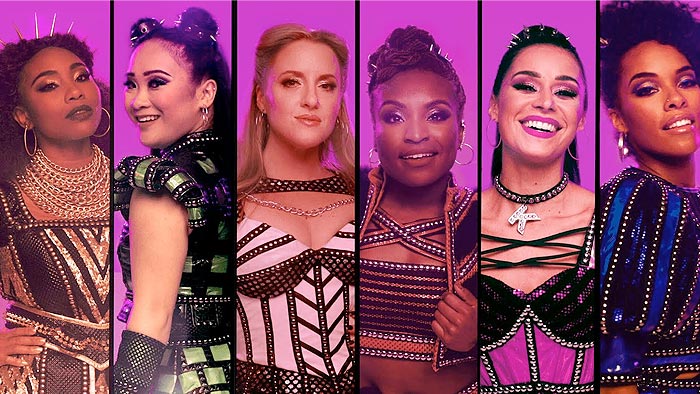
Works Cited
Borman, Tracy. “The Last Days of Anne Boleyn.” Accessed on YouTube on January 25, 2021.
Fanon Wiki. “Costume Meanings.” Accessed April 24, 2021.
Marlow, Toby & Lucy Moss. Six: The Musical Soundtrack. Absolute Label: Released December 18, 2017.
Worsley, Lucy. Secrets of the Six Wives. Accessed on PBS April 25, 2021.
What do you think? Leave a comment.











My sister introduced me to this. We watched the “bootleg” version on YouTube, as well as the animatics. My favorite song is “All You Wanna Do.” Love the wordplay and innuendo.
Your article goes into great detail on each queen and how she is portrayed in “Six.” It’s a good look at one of the most underrated musicals in recent memory!
Saw this fantastic musical in Australia 2020 before the Pandemic! Upbeat, bouncy and unforgettable!
Ooh, jealous! Kidding, but would love to see it. Would love to act in it, too, although I’m right at the age limit. It would probably be in a community version/summer stock. But I’m not picky.
Fun fact: two Cambridge students wrote this musical, for like a history project or something (I think) and then it got produced.
I still can’t believe that musicals make you laugh and cry, but most importantly they make you dance around your room at 3 am screaming about getting your head chopped off.
I know, right? And how many other musicals can you say that about? Here’s a hint: none. 🙂
Theatre kids and me: Dancing to songs about a bunch of people who aren’t alive anymore.
In the future when we create time machines theater kids will buy them to change musicals so it has a happier story or to have Alexander Hamilton watch Hamilton or the Six queens watch Six.
I would pay big money to see that.
Just a thing for the history nerds: Catherine Parr was rumored to be a black widow that continued to marry her way up in society only to kill her husbands.
What, thats kinda messed up. A horrible accusation really, considering she was one of the most expressively devout/religious of the wives.
I wish they had stayed with more of a historical costume design like Hamilton did, I get that with how Six has more of an upbeat music type and Hamilton is more chill but still rocks and that it’d have been harder to make work with how upbeat this one is but it still would have been cool as well as make me like the designs.
I had the same thought. I understand why they went with the pop costumes because as you said, those are easier to work around an upbeat musical. Plus, the queens are making fun of how history portrays them, so it might be weird if they wore traditional, historical costumes. But I personally would’ve loved historical costumes because of the contrast between those and the nature of the musical. Highbrow/lower-brow mashups are some of my favorite things.
I don’t. People are already saying this was a Hamilton rip off so. Also, It would be kinda weird to have historical outfits on a pop concert stage.
Ok everyone: Name your favorite show cast. I liked a mix of the different ones.
I prefer the cast members from Original UK tour (2018) & West End cast (2019) or The Original North American tour (2019).The acting and singing were both better and the costumes was probably the best change than from the previous ones.
My cast would be:
– Adriana
– Andrea
– Natalie
– Alexia
– Samantha
– Maiya
There you go. What’s yours?
I learned about the musical from the original London cast/listening to the soundtrack, so they’re my favorites.
I’ve become obsessed with heather the musical, six the musical, Hamilton the musical I’m becoming a theater kid I can’t even sing.
Catherine of Aragon = The Abandoned Queen
Anne Boleyn = The Temptress
Jane Seymour = The Mother
Anne Of Cleeves = The Luxurious Queen
Katherine Howard =The Forgotten Queen
Catherine Parr = The Sagacious One
Great read. I kinda feel as though they are the reincarnation of the six queens here too tell the real story.
I’ve performed at the Royal Albert Hall twice with my Theatre company, at it’s only just hit me that I have performed on the same stage as the cast of Six, probably my favourite musical.
If there was one Queen that they could “re-do” so to speak, I would want it to be Anne Boleyn. I know the creators have spoken about their dissatisfaction with her character since she is often portrayed as a social climbing seductress. Even though they subverted the trope by making her a more “I’m just here for the fun” type character, I wish they portrayed her more the the victim she was.
I had the same thought when I first heard “Don’t Lose Your Head” and saw digital excerpts. Now, my *personal* belief is that Katherine of Aragon was Henry’s wife in the sight of God, and so the whole “six wives” thing should’ve stopped at the beginning, never should’ve happened. Katherine of Aragon was, to me, the only “real” wife. And I think Anne *may* have calculated her way to the throne, at least partially.
Having said that, I don’t care which wife it was, Henry was an abusive, power-hungry, arrogant **** (word I won’t use). None of his wives deserved what they got from him, and that goes double for Boleyn and Howard, who were straight up murdered. I don’t believe Anne cheated, I do believe she loved Henry at least for a time, and I do believe she was innocent (even if she did scheme or calculate some, she got in over her head, no pun intended). After all, it’s not as if she could say no once Henry decided he wanted her.
If I could redo, I would definitely want to see a song that made more use of Anne’s intelligence and the deeper parts of her personality (bubbly and wants fun, maybe, but not a ditz). I’d also want her to speak directly to the fact that she didn’t expect or deserve what was coming. Maybe even empathize a little more with Howard. If you’ve seen The Tudors, there’s an episode where Henry speaks with Anne’s ghost and she says, “Katherine…lies in the cold ground next to me…poor child.” And just–oof! Gut punch right there.
It sounds like a ‘Great Histories’ sketch!
Their costumes are all based on female pop stars right? Howard is Ariana Grande, Aragon would be Beyonce, Parr-Alicia Keys, Seymour-Adele, but what about Cleves and Boleyn? Cleves looks like Missy Elliott what with the boyish style. What about Boleyn though I have actually no clue.
I’ve heard different interpretations. Anne is supposedly either Lily Allen or Avril Lavigne.
Ok legit Henry VIII must’ve liked Katherines. Half of his six wives were named Katherine.
An Abundance of Katherines? 🙂
The historical Spice Girls.
I’ve only seen digital version of this musical. At the end of Cleves’ part, Howard cuts her off. Whether it was to stop her from saying what we all know what she was about to say or was just her being impatient, i prefer the latter. Since Katherine was really young when she died, i expect her to be just a little less mature than the others, and i find cutting people off childish and imature. Idk, it’s just her characterization is really nice to me. In her song she uses kiddy language (“birds and the bess me,” for example) and it just kinda reminds me that she was reallllllyy young.
And that is what I love about the characterizations. As you said, there are subtle hints to who every queen is beneath the surface. I think you nailed Katherine Howard, but the others have those hints, too. Like Anne Boleyn not even paying attention when it’s her turn, but then trying to start another song, and making jabs at Aragon during her solo. The characterization kind of reminds me of the historical debate–was Anne a homewrecker or innocent (not paying attention at first)? But then, once she’s queen, once she’s “onstage,” that’s her position and if you get in her way, she’ll take you down.
Jane Seymour is that one friend who subtly insults everybody and you don’t realize until the conversation has moved on and you can’t call it out.
Historian Lucy Worsley believes Jane “played a canny hand,” in that she learned from Aragon and Boleyn’s mistakes, and played the shrinking violet simply because she knew it would keep her from ticking Henry off (again). If that’s what she did, I give her plenty of props. But I tend to believe Jane really had a meeker personality. It’s not that she was a doormat, though. It’s that her natural personality contrasted enough with Henry, and balanced him out enough, that the match could’ve worked if she lived. And if she lived, I believe she would have eventually had enough of Henry’s trust to speak up more and have him listen. For instance, history does tell us Jane was the one who got Mary back into Henry’s good graces, and did try the hardest to unify the family. Mad respect from me.
Imagine people acting as your former wives dissing you in front of the citizens of the country you once ruled…and they’re cheering for them.
I honestly want Henry to just magically come to life and watch six to see his reaction that would be hilarious.
According to the costume designer she took inspiration from different pop icons to make the Queens costumes. Their songs also have similarities to the artists!
Aragon = Beyoncé
Boleyn = Lily Allen
Seymour = Adele
Cleves = Rihanna/Nicki Minaj
Howard = Ariana Grande
Parr = Alicia Keys
Thanks for introducing me to this musical. I am already obsessed.
Sticks in your head, right? I’ve always liked the Tudor period, and now? Well, the soundtrack is definitely one of my jams.
My little brothers history teacher made his students watch the whole musical from different animatic videos on YouTube to study and learn about Henry’s wives. He also did the same with Hamilton when learning about the American revolution. Now my little brother plays Six on repeat. Happiest day of my life.
I love that story so much. His teacher needs a raise, BTW.
Imagine if the queens could see this now, years after their deaths, we’re celebrating them, instead of their husband and giving them the recognition.
I personally would love to see us invent time machines so we could sit Henry VIII down and watch him get royally roasted.
I still love the fact that I discovered Six The Musical just right before our class tackles the English Reformation.
Just curious: which one of the six wives of Henry VIII would you want to play (since you mentioned that you would)? Anyways, nice article!
Now, that is a tough question! I don’t think Boleyn, Cleves, or Howard are “me,” or how I’d handle the situation, esp. if the director were typecasting. So that leaves Aragon, Seymour, or Parr, and well, they all have great selling points. Plus, they all have some aspect of my personality or how I’d choose to deal with Henry. But if I had to choose, I’d probably pick Aragon. I can identify with her, true, but I also respect the way she dealt with her situation, maybe the most. And of those three, her song is definitely the most fun!
Teacher: Right so today we’ll be learning about a guy named Henry the eighth
My friend: Ah shit here we go goes and turns lights off
Me: LISTEN UP LET ME TELL YOU A STORY
This musical teaches me more than my history teacher.
When you want to be a part of a girl band but do musical theater.
Watched a clip of it on YouTube. I love the way Katherine sings “lock up your husbands, lock up your sons” it’s meant to sound flirtatious but it sounds more like a warning. Lock them up and away from her.
So my ex-wives decided to make…AN AMAZING MUSICAL TO DISS ME!?
The power in this musical is unparalleled.
Amen to that. We need more like it. Hamilton, Les Mis, Six…we need an entire canon’s worth of historical musicals, and it seems we’re getting there.
This musical has become my obsession within a day other obsessions of mine took weeks sometimes even months to evolve i don’t know whether i need help.
If you need help, we all do. Six is quite the addictive little musical and quite frankly, I enjoy my fixes.
This is a theatre show, a pop concert, and a history lesson rolled into one.
When you’ve see Six, Hamilton, hadestown, and Percy jackson, les miserables, 1776, scottsborro boyz, angels in america, and the great comet. I’m basically a history expert.
Let’s all be honest here. We have to give Henry SOME credit, he made the perfect pattern!
I truly appreciate that they opened up the casting for these roles and didn’t limit them. Great read, thank you for sharing!
Believe it or not, this is my first time hearing about this musical. I’ll definitely have to check it out in more detail. I’m always a fan of stories that break the bounds of convention to properly do their thing, bending time periods and both musical and narrative genres. This being a celebration of a very specific corner of history does it further justice. It’s clear there’s a lot to love here. Thanks for writing this, now I know what to look for.
Ahhhh, welcome to the club!
Imagine spending an hour and a half in ten inch heels dancing to songs like these.
When the music teacher and the history teacher are married.
This sounds like a really intriguing and inventive concept for a musical.
Six: The Musical is an amazing and truly enjoyable production, for many of the reasons explored in this piece, that deserves all its success, but I think that their popularity is partially the result of their approach and inclusion of technology within the production. For example, the inclusion of the Megasix where fans are encouraged to record the medley allows fans to share and engage with casts from the global productions and supports technological participation in ways that are often avoided by other productions, often based on fears of discouraging audiences from attending. The Megasix arguably does the opposite, by encouraging new audiences and the return of past ones.
Excellent overview and in-depth study of SIX–cannot wait to see it, and glad it is now a hit on Broadway. JW
As a broadway fan and a mini-history geek, I LOVED reading this!